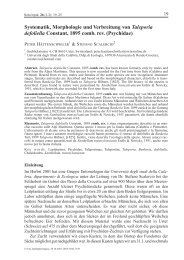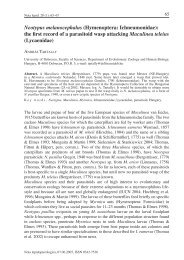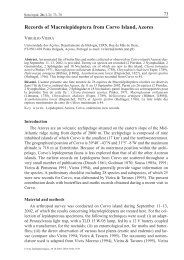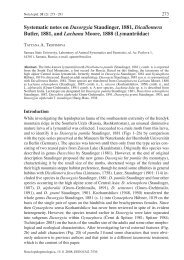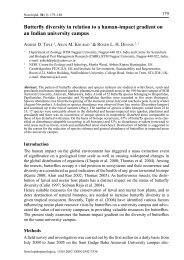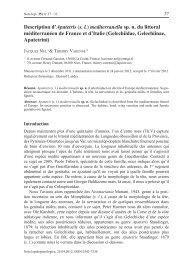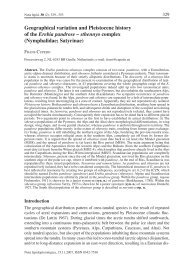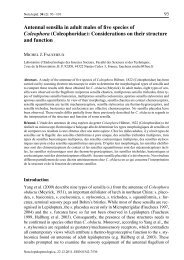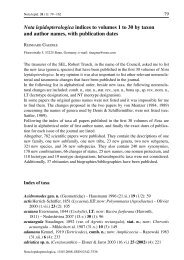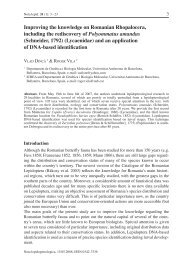Checklist of Butterflies (Papilionoidea) of the Mongolian Altai ...
Checklist of Butterflies (Papilionoidea) of the Mongolian Altai ...
Checklist of Butterflies (Papilionoidea) of the Mongolian Altai ...
Create successful ePaper yourself
Turn your PDF publications into a flip-book with our unique Google optimized e-Paper software.
80 YAKOVLEV: <strong>Butterflies</strong> <strong>of</strong> <strong>the</strong> <strong>Mongolian</strong> <strong>Altai</strong><br />
* Erebia callias Edwards, 1871<br />
Recorded in border regions <strong>of</strong> Russian part <strong>of</strong> <strong>Altai</strong> (Ukok plateau, Tashanta etc.), not<br />
found in <strong>the</strong> <strong>Mongolian</strong> <strong>Altai</strong>. In Russian <strong>Altai</strong>, ssp. altajana Staudinger, 1901 (Figs<br />
22a – b, 23a, 25). In 2003 Erebia callias chastilovi Churkin, 2003 from <strong>the</strong> Khan-<br />
Taycharyn-Ula Mountains and <strong>the</strong> Tsakhir-Khalgyn-Nuruu Mountains was described<br />
as a subspecies that is very different externally from <strong>the</strong> typical <strong>Altai</strong>an, Sayan, and<br />
Pribaikal species populations. Considerable distinguishing characters have been revealed<br />
in <strong>the</strong> genitalia morphology, which helps establish its specific rank and establish<br />
a new status Erebia chastilovi Churkin, 2003, stat. n.<br />
Erebia przhevalskii sp. n. (Figs 22e – h, 23b, 24 a – d, 25)<br />
Material. Holotype P, W. Mongolia, Hovd aimak, Bulgan-Gol basin, Uljastyin-Gol Valley, Shadzgat-<br />
Nuruu Mountains, 2800 – 3000 m, 25 – 26.vi.2004, R. Yakovlev & D. Ryzhkov leg. (ZISP). – Paratypes:<br />
40 PP, 5 OO, same data; 5 PP, 3 OO, W. Mongolia, Bayan-Ulegei aimak, Kobdo-gol Valley, 20 km<br />
SW Tsengel, 2400 m, 48°49’N; 88°59’E, 25 – 27.vii.2010, E.V. Guskova & R.V. Yakovlev leg (SZMN,<br />
RYB).<br />
Description. Forewing length 16.5 – 17.5 mm. Male: Wings wide, rounded apically,<br />
with a semicircle on outer margin; upperside dark brown. Forewing with an ochreous<br />
area postdiscally, a double black ocellus near apex, centered with a pair <strong>of</strong> white pupils;<br />
underside with a broad ochreous zone medially, greyish areas marginally, a double<br />
black ocellus apically, centered with a pair <strong>of</strong> white pupils. Hindwing in half <strong>of</strong> specimens<br />
with small ochreous dashes submarginally and 1 – 3 small black ocelli; underside<br />
pale grey, with a broad band rough at margins in discal area, narrowing towards tornus.<br />
A number <strong>of</strong> specimens bearing 1 – 3 black ocelli submarginally. Female: Externally<br />
similar to male, with a better defined ochreous pattern on forewing upperside; hindwing<br />
underside marmorate, patterned with very small brownish streaks.<br />
Male genitalia. Uncus long, hook-shaped; gnathal arms acute apically, shorter than uncus.<br />
Tegumen medium-sized. Valva long, strongly narrowing apically, with a long acute<br />
process on costal margin (in its middle third), upward and forward directed, with 1 – 2<br />
smaller acute denticles, directed backward and forward, on <strong>the</strong> narrow end <strong>of</strong> valva<br />
distally. Saccus small. Phallus short, thick, straight.<br />
Female genitalia. Ovipositor lobes semicircle apically. Apophyses posteriores short,<br />
poorly sclerotized. Antevaginal plate U-shaped, very small, broad basally, with very<br />
small lateral processes. Ductus bursae short; corpus bursae more or less round, with a<br />
pair <strong>of</strong> ribbon-like signa.<br />
Habitat. The butterflies are found in humid tundra associations with Cobresia (Cy per<br />
a ceae) pr evailing.<br />
Diagnosis. The new species is very different from <strong>the</strong> known taxa <strong>of</strong> <strong>the</strong> group in <strong>the</strong><br />
shape <strong>of</strong> <strong>the</strong> valva – <strong>the</strong> abrupt narrowing towards <strong>the</strong> apex and specific upward and<br />
forward directed denticles on <strong>the</strong> costal margin, where <strong>the</strong> larger denticle is <strong>the</strong> most<br />
proximal. The female genitalia differ in having a tiny antevaginal plate.<br />
Etymology. The species is named after a well-known Russian geographer N. Przhevalsky<br />
(1839 – 1888).



